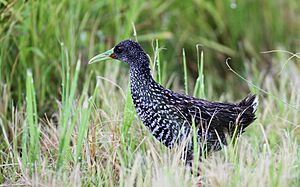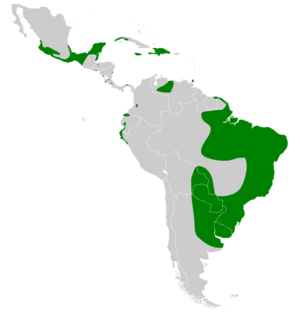Spotted rail facts for kids
Quick facts for kids Spotted rail |
|
|---|---|
 |
|
| Conservation status | |
| Scientific classification | |
| Genus: |
Pardirallus
|
| Species: |
maculatus
|
 |
|
The spotted rail (Pardirallus maculatus) is a cool bird. It belongs to the rail, crake, and coot family, called Rallidae. You can find this bird in many places. It lives in Mexico, Central America, the Caribbean islands, and South America.
Contents
Meet the Spotted Rail: What It Looks Like
The spotted rail is about 25 to 28 centimeters (10 to 11 inches) long. It weighs between 130 and 220 grams (4.6 to 7.8 ounces). Female birds are a little smaller than males. Both male and female spotted rails look very similar.
They have a long, greenish beak. There is a red spot near the base of their lower beak. Their legs are pinkish. These birds have a blackish head and a red eye. Their upper body is black and brown. Their belly and chest are black with white stripes and spots.
There are two main types, or subspecies, of the spotted rail:
- P. m. insolitus
- P. m. maculatus
The P. m. maculatus type has white stripes on its upper parts. The P. m. insolitus type has white spots instead.
Where Do Spotted Rails Live?
The P. m. insolitus subspecies lives from Mexico down to Costa Rica. The other subspecies, P. m. maculatus, is found in many places. These include Cuba, Hispaniola (which has the Dominican Republic and Haiti), and Jamaica. It also lives in almost every country in mainland South America. It has even been seen in Chile, but only rarely.
Spotted rails live in Panama, but scientists are not sure which subspecies is there. They are not found everywhere in these areas. Instead, they live in specific, local spots. Sometimes, they travel far from their usual homes. They have been seen in Trinidad, and even in the U.S. states of Pennsylvania and Texas.
These birds love wet places. They live in marshes, swamps, and rice fields. They also like wet grasslands. They need lots of thick plants to hide in.
Spotted Rail Behavior: How They Live
Movement and Travel
Spotted rails do not have a set pattern for moving around. However, they do move locally. This happens when water levels change or during dry times. They have also been known to wander far from their usual homes.
What Do Spotted Rails Eat?
The spotted rail looks for food in shallow water. They also search along the water's edge. They usually stay hidden in plants. But at dawn and dusk, they might feed in more open areas.
Their diet includes many things. They eat earthworms and insects, both adults and their young. They also eat other small creatures without backbones. Sometimes, they eat small fish and water plants like pondweed.
Reproduction and Life Cycle
The breeding season for spotted rails changes a lot. It depends on where they live. During this time, they seem to protect their territory.
They build a nest that looks like a cup or bowl. They make it from grass or dead rushes. The nest is usually in plants near the ground. Often, it is built above shallow water. A female spotted rail lays between two and seven eggs. We don't know how long it takes for the eggs to hatch. We also don't know how long it takes for the young birds to be ready to fly.
Vocalization: What Sounds Do They Make?
The spotted rail makes a loud, harsh, groaning screech. It often starts with a grunt or pop sound. This call might be used to claim their territory or show aggression. They also make a series of deep, pumping notes that get faster. Another sound they make is a sharp, repeated "gek." Sometimes, they call out at night.
Spotted Rail Status: Are They Safe?
The IUCN (International Union for Conservation of Nature) has looked at the spotted rail. They say it is a species of "Least Concern." This means it is not in immediate danger. The bird lives across a very large area.
However, there are not many of them. Scientists guess there are only 670 to 6,700 adult birds. We don't know if their numbers are going up or down. No big threats have been found for them right now. Scientists believe these birds are often missed. They are hard to see, especially when they are breeding. This means they might be more common than we think.
Images for kids




